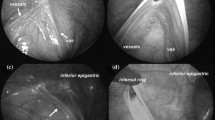Abstract
Background
Open herniotomy has been the gold standard of pediatric hernia treatment with the advantages of simplicity in surgical technique, fast post operative recovery, and minimal recurrence rate, but its inability to prevent hernia development from a contralateral patent processus vaginalis (PPV) after a unilateral herniotomy is its major drawback. By contrast, laparoscopic hernia repair has the advantage of contralateral internal ring inspection, and, therefore, has become popular in recent years, although open herniotomy is still the favorable surgical technique among many surgeons. A simple and reliable tool to detect contralateral PPV will be valuable to surgeons who practice conventional open hernia surgery on children, although ultrasound has been applied for this purpose, but there is no long-term data to support such application.
Method
The author performed a preoperative ultrasound on the contralateral groins of children undergoing unilateral herniotomy or PPV ligation. If the ultrasound showed no evidence of contralateral PPV, no contralateral surgery was performed. Those patients were then followed up after a long period of time to see whether contralateral hernia or hydrocele was developed or not.
Results
322 pediatric patients were studied from 2006 to 2012. In 96 of the cases (30%), contralateral PPV were identified with ultrasound, and 95% of which were affirmed intraoperatively. In the remaining 226 patients who were without evidence of contralateral PPV, only unilateral surgeries were offered. One of these patients later developed contralateral hernia and required another surgery. The remaining patients were phoned up after a median period of 9 years. 114 of them could be contacted and none of them had developed contralateral hernia or hydrocele.
Conclusions
Ultrasound groin is a valuable tool as an adjunct in pediatric hernia management by detecting contralateral PPV with high accuracy. Surgeon can offer unilateral or bilateral hernia surgery according to the ultrasound finding, and the incidence of contralateral hernia development is negligible. Preoperative ultrasound groin with selective contralateral PPV closure in children can be an alternative to routine laparoscopic hernia repair in avoiding contralateral hernia or hydrocele development.
Level of evidence
Level 3.
Type of study
Retrospective study.













Similar content being viewed by others
References
Tackett LD, Breuer CK, Luks FI, Caldamone AA, Bruer JG, Deluca FG, Caesar RE, Ethemiou E, Wesselhoeft CW Jr (1999) Incidence of contralateral inguinal hernia; a prospective analysis. J Pediatr Surg 34(5):684–687 (discussion 687–688)
Yerkes EB, Brock JW III, Holocomb GW III, Morgan WM III (1998) Laparoscopic evaluation for a contralateral a patent processus vaginalis: part III. Urology 51(3):480–483
Ostlie DJ, Ponsky TA (2014) Technical options of the laparoscopic pediatric inguinal hernia repair. J Laparoendosc Adv Surg Tech A 24:194–198
Zani A et al (2014) Management of pediatric inguinal hernias in the era of laparoscopy: results of an international survey. Eur J Pediatr Surg 24(1):9–13
Hata S, Takahashi Y, Nakamura T, Suzuki R, Kitada M, Shimano T et al (2004) Preoperative sonographic evaluation is a useful method of detecting contralateral patent processus vaginalis in pediatric patients with unilateral inguinal hernia. J Pediatr Surg 39:1396–1399
Toki A, Watanabe Y, Sasaki K, Tani M, Ogura K, Wang ZQ et al (2003) Ultrasonographic diagnosis for potential contralateral inguinal hernia in children. J Pediatr Surg 38:224–226
Erez L, Rathause V, Vacian L, ZharE Hoppenstein D, Werner M, Lazar L, Freud E (2002) Preoperative ultrasound and intraoperative findings of inguinal hernias in children: a prospective study of 642 children. J Pediatr Surg 37(6):865–868
Chen KC, Chu CC, Chou TY, Wu CJ (1998) Ultrasonography for inguinal hernias in boys. J Pediatr Surg 33(12):1784–1787
Kervanciogiu R, Bayram MM, Ertaskin I, Ozkur A (2000) Ultrasonographic evaluation of bilateral groins in children with unilateral inguinal hernia. Acta Radiol 41:653–657
Huang S, Yang X, Li C, Qian Y, Zhao Z, Liang J (2018) Pre-operative spermatic cord ultrasonography helps to reduce the incidence of metachronous inguinal hernia in boys. Front Pediatr 6:156
Weaver KL, Poola AS, Gould JL, Sharp SW, St. Peter SD, Holocomb GW III (2017) The risk of developing a symptomatic inguinal hernia in children with a asymptomatic patent processus vaginalis. J Pediatr Surg 52:60–64
Author information
Authors and Affiliations
Corresponding author
Ethics declarations
Conflict of interest
The Author declared no conflict of interest.
Ethical approval
The study complied with the current laws of the country in which they were performed.
Human and animal rights
The study including human participants has been performed in accordance with the ethical standards of the Declaration of Helsinki and its later amendment.
Informed consent
Informed consent was obtained from all individual participants included in the study.
Additional information
Publisher's Note
Springer Nature remains neutral with regard to jurisdictional claims in published maps and institutional affiliations.
Rights and permissions
About this article
Cite this article
Yip, P.K.F. Ultrasound detection and closure of contralateral patent processus vaginalis in pediatric patients with unilateral inguinal hernia and hydrocele: a longitudinal study to prove efficacy in avoiding contralateral hernia development. Hernia 23, 1253–1259 (2019). https://doi.org/10.1007/s10029-019-01951-7
Received:
Accepted:
Published:
Issue Date:
DOI: https://doi.org/10.1007/s10029-019-01951-7




